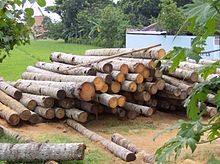- Coconut timber
-
Coconut timber is a hardwood-substitute from coconut palm trees. It is referred to in the Philippines as Coconut Lumber, or Coco Lumber. It is a new timber resource that comes from plantation crops and offers an alternative to rainforest timber.
Contents
Background
Coconut timber comes from farmed plantations of old coconut palms. The coconut palm was planted as a crop in large plantations throughout the tropics in the early half of the 20th century in order to harvest the coconut fruit. The tree bears fruit until approximately 70 years of age, at which point it is considered to have reached the end of its economic life and is felled to make way for future crops. Each year, several million palms are felled throughout the tropics. Traditionally, the trunks have been wasted by-products from this process.
Only in very recent years have people begun to explore the potential commercial uses for this vast, alternative supply of timber. This led to the commercial launch of coconut timber in a range of different products, from flooring to posts to furniture. With these products performing at equal to or even better than conventional hardwoods, coconut timber represents a viable substitute for endangered hardwoods from an ecologically-sound source.
Characteristics
Its wood is reminiscent in appearance to mahogany; however, coconut timber has a much more fibrous grain than mahogany and lacks the same level of iridescents. Colour tones and hues range from golden to near ebony, with dark brown flecks. There are three basic colour divisions relating to the timber's density: dark brown tones (high density); medium brown tones (medium density); and light golden tones (low density).
Coconut trees have no annual growth rings, rays, heartwood or branches, meaning that coconut timber is free from knots and other such imperfections.
Properties
The coconut palm is a monocotyledon. It has a smooth, slender stem that grows to a height of about 25 metres and with an average diameter of 300mm. The hardest, densest part of the wood is found on the outer perimeter of the trunk, which gives the tree its strength, while the wood’s high silica content gives the tree elasticity. Towards the centre of the trunk, the wood gets less hard.
Coconut timber is classified according to three degrees of density:- High-density timber (dermal) – hard: 600-900kg/m³
- Medium-density timber (sub-dermal) – medium/hard: 400-600kg/m³
- Low-density timber (core) – soft/medium: 200-400kg/m³
- Coconut = 112,5 - 154,7 kgf/cm2 (1600 – 2200 psi) dependent on which figures you look at
- Oak between 70,3 - 84,4 kgf/cm2 (1000 – 1200 psi) dependent on type of oak.
- Douglas-fir = 35,9 kgf/cm2 (510 psi)
Usage
Coconut timber has many applications as both a structural and interior design material. The harder, high-density timber is suitable for general structural purposes such as pillars, trusses, rafting, furniture, window and doorframes, floors, decking and floor joists. Medium density coconut timber can be used for walls, ceiling joists and horizontal studs. Low density coconut timber is used in non-load bearing applications like wood panelling, internal trim and ceilings, as well as homewares.
References
- Modern Coconut Management: palm cultivation and products; J.Ohler (1999)
- Asia-Pacific Forestry Sector Outlook Study: Focus on Coconut Wood; Food and Agricultural Organization (FAO) of the United Nations (1997)
- Tapping the Tree of Life; W.Pyper (2001)
- Coconut Program Area Research Planning and Prioritization; C.Aragon (2000)
- Coconut Wood Processing and Use; Food and Agricultural Organization (FAO) of the United Nations (1985)
- State of the Art: Cocowood Utilization; R.Palomar (1990)
See also
Sustainable flooring#Coconut Timber Flooring
Categories:- Palms
Wikimedia Foundation. 2010.


